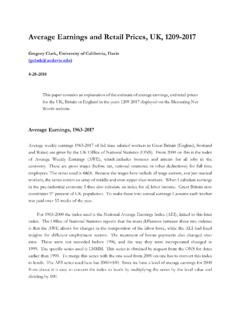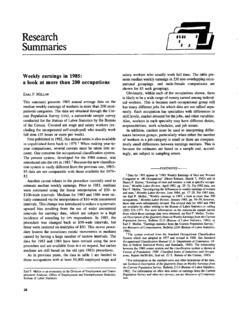Transcription of Defining and delivering effective counselling and ...
1 CHILD FAMILY COMMUNITY AUSTRALIA INFORMATION EXCHANGED efining and delivering effective counselling and psychotherapyLawrie MoloneyCFCA PAPER NO. 38 20162 | Australian Institute of Family StudiesCHILD FAMILY COMMUNITY AUSTRALIAF ollowing a brief historical summary of three mainstream approaches, this paper addresses the similarities and differences between the terms counselling and psychotherapy. After settling on counselling as the default term, the paper then provides a comprehensive definition, explores counselling s essentially voluntary nature and examines the practice and research divide between individual, couples and family focused work. Though there is good evidence for the effectiveness of individual, as well as couples and family counselling , it is acknowledged that amassing the evidence with respect to couples and family work has proved to be a more challenging task. The finding that the strength of counselling effectiveness has altered little over the past 40 years is then linked to the question of how counselling works.
2 The evidence points away from a medically grounded focus on differential effects of particular models of counselling , towards common factors especially the nature of the counsellor client alliance that appear to be present in all successful counselling outcomes. The common factors findings, in turn, suggest the need for a shift in focus from the relative efficacy of differing models of counselling to research into counsellor training and the ongoing development of counsellor expertise. A key correlate of this continued development has been shown to be counsellors capacity and willingness to seek and act upon client feedback. Moreover, the formalisation of a feedback-informed approach via validated, user-friendly client feedback protocols permits the monitoring of outcomes on both a case-by-case and aggregate basis. This in turn provides a way forward with respect to developing an ongoing accountability framework for counsellors, counselling agencies and their funders.
3 Differences between counselling and psychotherapy are largely in the eye of the beholder; both are relatively recent, mainly personally focused approaches to centuries-old traditions of providing culturally appropriate responses to problems of living . Medically informed models of how counselling and psychotherapy work continue to inform much theory and practice, and have prompted thousands of studies seeking evidence for and against the relative efficacy of different treatment approaches. Almost all well conducted studies of mainstream counselling interventions have concluded that regardless of the model used, the average effect size of counselling (discussed in the body of the paper) is substantial and compares well with effect sizes achieved in established medical practice. Unlike medical interventions however, the effect size has little if anything to do with the particular model of treatment employed; rather, effects are linked to factors found to be common to all counselling interventions.
4 Somewhat counter-intuitively, there is no convincing evidence that counsellor gender, qualifications, theoretical orientation, professional discipline or even years of experience impact noticeably on outcome; there is evidence that effective counsellors tend to be consistently effective , while ineffective counsellors tend to be consistently MESSAGESD efining and delivering effective counselling and psychotherapy | 3 counselling and psychotherapy in a contemporary context: What is it?All the (healing) precursors to psychotherapy .. bear a resemblance to each other and to later forms of healing like psychotherapy. (Duncan, 2014, p. 15)Federal, state and local governments throughout Australia support a large range of counselling services in the belief that they provide an effective means of improving the lives of individuals, couples and families. It will be seen that broadly speaking, this belief is justified. But what gives counselling its potency?
5 Impressive effect sizes demonstrated by research need to be reconciled with the fact that since its development in Western countries at least 400 intervention models and at least 145 manualised treatments have been developed, while more than 10,000 how to books on the talking cure 1 have been published (Beutler et al., 2005, cited in Miller, 2013). Not surprisingly, this plethora of options has been accompanied by much ongoing debate about the true nature of counselling and developments of counselling and psychotherapy during the first half of the 20th century are provided in Box 1 (page 4). After demonstrating that differences between counselling and psychotherapy are largely in the eye of the beholder, the paper provides a comprehensive definition of counselling , the word used as the default descriptor in the remainder of the paper then summarises the evidence regarding whether or not individual, couple and family counselling works and how it works.
6 Evidence about how counselling works leads to a brief discussion of the critical question of how counsellors develop and maintain expertise and how, as an essentially private process, counselling can nonetheless provide appropriate levels of accountability for clients, employers, funding bodies and of course for counsellors themselves. The paper concludes with a number of observations regarding future practice and psychotherapy: same or different?Before offering a definition of counselling , it is useful to address the ongoing issue of whether counselling and psychotherapy are significantly different or largely represent two sides of the same This description of the talking cure process was coined by Bertha Pappenheim, an early recipient of contemporary psychotherapy. A patient of Josef Breuer (more widely known as Anna O ; see Breurer & Freud, 1895), Bertha was cured of a range of symptoms through a process of talking and hypnosis.
7 Counsellors (as well as commentators and researchers) continue to struggle to reconcile models of individual counselling , focused mainly on internal emotional and cognitive processes, with couples or family counselling models focused mainly on quality of interactions between individuals. In both individual as well as couples and family counselling however, the focus of practice and research is increasingly turning to how the common factors that drive successful counselling interact with each other, and how counsellors gain, retain and develop their therapeutic expertise; research comparing the efficacy of differing models of counselling is unlikely to yield useful results into the future. Counsellors willingness to systematically elicit, record and make use of client feedback in the context of establishing a sound therapeutic alliance appears to be strongly associated with good outcomes;the use of validated client feedback protocols also allows for the routine monitoring of outcomes by counsellors themselves as well as by counselling organisations and funding | Australian Institute of Family StudiesCHILD FAMILY COMMUNITY AUSTRALIABox 1: Origins of the talking cure The seeds of contemporary approaches to counselling were probably sown in the wake of the Industrial Revolution.
8 Giddens (1991) has described how within the larger more urbanised societies emerging at that time, traditional rules of living were increasingly challenged, whilst norms governing personal relationships became less constrained. As power, responsibilities and protections supported by local knowledge and recognised reference points began to diminish, the capacity of traditional healers to influence individual and group behaviour also to Albee (1977), the gradual shift from life in villages and small towns to life within larger more anonymous societies prompted increased attempts to seek direction from within. The focus on inner direction, accompanied by the weakening of old certainties hitherto buttressed by religion and a sense of social and geographical belonging, created a need for more personalised help, guidance and with personal problems: the counsellor as expertIn the culture that followed the science-led Industrial Revolution, it is perhaps not surprising that science-informed alternatives to traditional morally and religiously based responses to problems of living began to gain acceptance.
9 Scull (1975) for example, has demonstrated how the medical model, resting on taxonomies of physical illnesses and diagnostic criteria, was recruited into also creating categories of psychological disturbance (see also Foucault, 1967).Experiments with hypnosis in the late 19th century, famously elaborated upon and eventually reinterpreted by Freud, represented an early departure from physically focused treatments. Though still firmly located within the medical profession,2 Freud s development of psychoanalysis contained two foundational insights that continue to inform much (though not all) contemporary counselling and psychotherapy. They are firstly, the importance of the relationship between therapists and their patients; and secondly, the idea that the origins of some psychological difficulties are not fully accessible to conscious rational about this time, behaviourism, an overtly rational approach to counselling , grew out of Pavlov s experiments with classical conditioning.
10 In the United States, Watson (1919) applied Pavlov s stimulus-response work with dogs to learning in human beings, while Skinner (1938) extended Watson s work by introducing the broader concept of operant behaviourists continue to argue that psychological interventions must be based on observable and measurable learning principles, most have accepted the limitations of attempting to explain complex behaviours (such as language) via linear chains of stimuli and responses (see for example Lashley, 1951). Most contemporary behaviourists acknowledge that the processing of emotions and/or cognitions must also be part of the learning equation. Hybrid models such as rational emotive therapy (Ellis, 1962) and cognitive behavioural therapy ( , Westbrook, Kennerley, & Kirk, 2011) have largely replaced earlier purer expressions of self-healing client: the counsellor as facilitatorBoth psychoanalytic and behaviourist approaches to alleviating psychological distress have tended to support top-down, expert-driven interventions.



